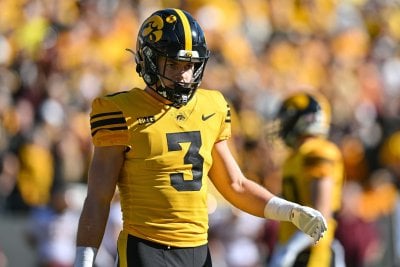The Passing Chronicles: All Go HB Seam in 2020
By DustyEvely

Over the past couple of months, we’ve gone back to break down some iconic plays throughout Packers history. We covered Lombardi’s Sweep, the Packers bringing a blitz that changed Super Bowl II, Brett Favre’s audible to kick off scoring in Super Bowl XXXI, Tim Masthay throwing a TD pass to Tom Crabtree, Greg Jennings reading Troy Polamalu and picking up a TD in Super Bowl XLV, and more! Much more! I learned a lot and had a tremendous amount of fun, and I hope you all did as well.
With the season creeping up, I wanted to turn my attention to something a little more recent. Instead of digging back into the distant past, we’re going to start looking at some of the major passing concepts the Packers ran in 2020. I’ve covered the vast majority of these at one point or another during the season, but I thought it would be fun to look at them in their individual groups. It’s possible you and I have different definitions of the word “fun”, but I guess we’re gonna find out.
We’re kicking off this series with my personal favorite: All Go HB Seam. In the world of schemes, this is a relatively recent one, but it’s been around for a few years at the NFL level. The first time it really hit my radar was in Week 1 of the 2017 season, when the Chiefs rolled into Foxboro and beat the Patriots 42-27.
The concept is believed to have been started at North Dakota State, so it had been kicking around the college ranks for a few years, but 2017 was when it made its grand entrance to the NFL. Like all new concepts, it wasn’t long before it made its way into everybody’s playbook.
Mike McCarthy used the concept in his last couple of years, but Matt LaFleur has really made it a staple of the offense. Between the regular season and playoffs, I have the Packers running this 21 times, which comes out to 1.17 times per game.
It’s an overload concept that requires a minimum of 3 routes to be run to one side of the field. It is typically run with 4 routes to one side of the formation, with a single route on the backside of the formation. Let’s look at the routes.
This concept revolves around 3 main routes, but it also features a flat option – usually underneath the 3 main routes – and it typically also includes a backside route. The routes are:
1. Vertical route up the sideline
2. Deep crossing route
3. Seam route from the backfield
4. Flat route
5. Backside route (usually a quick out or slant)
Flat Route
In the play above, the throw went to Jamaal Williams in the flat, who makes a man miss and picks up 15 yards. Of the 20 throws on this concept, 9 (45%) of them went to the flat, averaging 4.33 yards per attempt. Ideally, the concept would catch defenses rotating and the throw up the seam would be open (as we saw in the clip of the Chiefs game above). As this concept has become more popular, defenses have started sinking back on it, covering up the deep routes and leaving the underneath open. The flat option doesn’t always pick up a lot of yards, but it can be a way to get a playmaker in space.
Outside Route
In 2020, the Packers didn’t attempt a single throw up the seam, which is a shame. I would have loved to see AJ Dillon haul in a pass up the seam with a head full of steam and a heart full of malice. Even with limited snaps, Dillon was the player who ran the seam route on this concept the second most on the team. Aaron Jones ran the seam route 7 times, and Dillon was right behind him with 6. Dillon will absolutely get his opportunities in 2021, and I’m really excited to see it.
With the seam covered up, the Packers’ best option for picking up chunks of yardage on this concept in 2020 was by hitting the outside receiver. When throwing to the outside receiver, Aaron Rodgers was 4/5 for 107 yards (21.4 YPA), and it could have been a lot more if not for an overthrow against the Texans that caused Tonyan to leave his feet to make the catch.
That throw is an example of my favorite version of this concept, because it plays off a concept the Packers throw a lot: the WR screen.
The inside receiver in the bunch releases laterally, which is the movement for a WR screen. The defense anticipates the other two receivers will be blocking, so they crash to beat the blocks. By the time they realize it’s not a WR screen, Robert Tonyan is screaming up the sideline. They used that specific variation 3 times. On those, Rodgers was 2/3 for 55 yards.
Backside Route
The backside route was one that wasn’t targeted much early in the season, but was used more as the season went on. The first time that option was targeted was in week 8, which went to Adams on a quick out route. Up until that point, pretty much every backside route was an out route. After week 8, they mixed in a couple drag routes to work underneath the main action. Against the Rams in the Divisional Round, they ran this concept twice, throwing backside to Adams on a slant both times.
Jalen Ramsey has Davante Adams man-to-man on the backside of the concept and is playing him straight-up. After the snap, Rodgers looks down the middle of the field to check the movement of the inside linebacker and the safety. The linebacker holds his ground and the safety retreats, telling Rodgers that if Adams wins on the slant, he’ll have space to hit him. Adams wins – because of course he does – and the play goes for 12 yards.
The Packers threw the backside route 5 times (20%), and it went for an average of 8 yards. The only time Rodgers was sacked on this concept was in the NFC Championship Game. He was looking for Adams on the backside slant, but the Bucs slid the linebacker over post-snap and the pass rush hit home before he could find anyone else.
Crossing Route
The Packers only targeted the crossing route 1 time, and it ended up as a 27 yard gain by Tonyan.
The jet motion bring the linebacker level up-and-over, allowing Tonyan to run free through the middle. There appears to be a little confusion with the coverage assignments on the back-end as well, which helps Tonyan to find some space.
As I said at the top, this is one of my favorite concepts. It stretches the defense horizontally and vertically, which leads to the potential of some big plays down the field. If the defense takes away the big plays, there’s a chance to get the ball in the hands of a playmaker in space. It’s also a good way to isolate a player on the backside and find a favorable man-to-man match-up. It can be run effectively from a number of different personnel groupings and different alignments. This concept gives a lot of options to beat a team.
In addition to that, the three main routes just look so pretty as they’re breaking down the field.
I hope you all enjoyed reading this half as much as I enjoyed researching and writing it. I look forward to diving into some more of the Packers core concepts over the next few weeks as we gear up for the 2021 season. I don’t know if I’ll get into the same depth in the future concepts that I did here, but I guess we’ll find out.
Before I go, here are a smattering of numbers.
- Of the 21 times they ran this play, 13 times were on 1st down, facing an average of 10 yards to gain. They averaged 10.85 yards per play on 1st down. The other 8 times they ran this play were on 2nd down, facing an average 7 yards to gain. They averaged 8.13 yards per play on 2nd down. They did not run it on 3rd or 4th down.
- The most productive week for this concept was the Week 4 game against the Falcons. The Packers ran this 3 times for an average of 18.67 yards per play. The only other time they ran this play 3 times in a game was the Week 11 Colts game, where it averaged 5.67 yards per attempt.
- They ran this out of Shotgun 90.5% of the time, averaging 10.5 yards per attempt. On the 9.5% of times they ran it from under center, they averaged 3 yards per attempt.
- They ran this out of 5 different personnel groupings. Their favorite grouping was 11 personnel (1 RB, 1 TE, 3 WR). They used that grouping 47.6% of the time and averaged 7.2 yards per attempt.
- They were more successful out of 12 personnel (1 RB, 2 TE, 2 WR). They used that grouping 28.6% of the time and averaged 13.3 yards per attempt.
- They used jet motion on 52.4% of the time, averaging 9.4 yards per attempt. When not using jet motion, they averaged 10.3 yards per attempt.
- They went against Middle Field Closed defense (single-high safety family coverage) 57.1% of the time, averaging 9.7 yards per attempt. Against Middle Field Open defense (two-high safety family coverage), they averaged 10 yards per attempt.
- Throws to the outside receiver in the concept accounted for 23.8% of the pass attempts but 51.9% of the total yardage from the concept.
- When defenses brought 5+ rushers, the Packers averaged 10.67 yards per attempt, a full yard higher than they did when not blitzed (9.67 yards per attempt).
Albums listened to: Phoebe Bridgers – Punisher; Garbage – Garbage; The Written Years – A Cinematic Goodbye; Julien Baker – Little Oblivions; Twin Shadow – Twin Shadow; Fleetwood Mac – Rumours; Manchester Orchestra – The Million Masks of God; The Sundays – Reading, Writing & Arithmetic; Basia Bulat – Are You In Love?; Ellis – Born Again; Spanish Love Songs – Brave Faces Everyone; Hum - Inlet
PLEASE SUBSCRIBE TO OUR CHEESEHEAD NATION WEEKLY NEWSLETTER HERE.
__________________________
Dusty Evely is a film analyst for Cheesehead TV. He can be heard talking about the Packers on Pack-A-Day Podcast. He can be found on Twitter at @DustyEvely or email at [email protected].
__________________________













Comments (10)
Coldworld
July 14, 2021 at 04:07 pm
Always a learning experience! Thank you.
wildbill
July 14, 2021 at 08:37 pm
I enjoy these type of articles 100% of the time
JerseyAl
July 14, 2021 at 09:02 pm
I remember seeing this on multiple occasions and couldn't remember it going to the HB seam route once. Glad you confirmed my suspicion. Great work as always!
NickPerry
July 15, 2021 at 06:56 am
Thank you Dusty, great work! I really love these pieces by you. I always learn something new from these posts. Keep them coming!
porupack
July 15, 2021 at 06:59 am
Thanks for the trend analysis and production vs varied usage. Really enjoyed the articles.
PatrickGB
July 15, 2021 at 01:39 pm
I also liked the trend analysis. Matt’s system can be confusing to most defenses. Yet using it sparingly helps mask the call. Good job Dusty!
KnockTheSnotOutOfYou
July 15, 2021 at 11:19 am
Awesome!!!
LambeauPlain
July 15, 2021 at 11:39 am
Great analytical article, Dusty. Interesting this attack was more effective out of 12 personnel.
Perhaps a future analysis would take a top line view of the production in the 12 personnel group. What percentage is it used and what is the avg/play?
My gut tells me 12 is the most productive formation, especially given the run game balance and the solid TE group....but I do not know.
Love these articles.
DustyEvely
July 15, 2021 at 02:06 pm
Sharp Football Stats actually has numbers for all teams' use of personnel groupings and how they do out of them. Really cool stuff.
Packers use 12 personnel 24% of the time (274 total snaps). They average 8.0 yards per attempt while passing and 5.4 yards per attempt while rushing.
11 personnel is their most common grouping, using it 55% of the time (617 total snaps). They average 8.1 yards per attempt passing and 5.3 yards per attempt rushing. So REALLY close on both of those.
croatpackfan
July 15, 2021 at 12:06 pm
Thank you for your lessons. It really helps me (and hopefully many of us) to better understand game and, consequently enjoy more...
I'm looking forward for future lessons ;-)